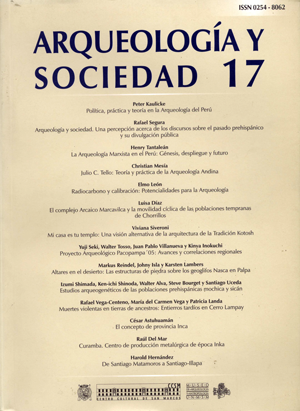Altares in the desert: The stone structures on the geoglyphs Nasca in Palpa
DOI:
https://doi.org/10.15381/arqueolsoc.2006n17.e13140Keywords:
Nasca, Palpa, plains, geoglyphs, mounds, stone structures.Abstract
In this article, we present the results of the excavactions conducted in severa! structures that were found in association with geoglyphs located in the Palpa Province, within the northern side of the Rio Grande Basin. Toe geoglyphs were built over slopes and plateaus that are placed within and long the Rio Grande, Palpa and Viseas Valleys. The reported data indicate that the construction of these geoglyphs started during the middle developmental stage of the Paracas Culture (ca. 500 B.C.) and ended with the final development of the Nasca Culture (A.O. 650). During this time, and specially during the Nasca time, the slopes and plateaus formed part of an active social landscape, where geoglyphs became the scenario for important festive and religious activities. Among them, activites realted to water and fertility cults were remarkable. These activities rnight have taken place in the stone structures associated with the geoglyphs.Downloads
Published
Issue
Section
License
Copyright (c) 2017 Markus Reindel, Johny Isla, Karsten Lambers

This work is licensed under a Creative Commons Attribution-NonCommercial-ShareAlike 4.0 International License.
THE AUTHORS RETAIN THEIR RIGHTS:
a. The authors retain their trademark and patent rights, and also on any process or procedure described in the article.
b. The authors retain the right to share, copy, distribute, perform and publicly communicate the article published in the Arqueología y Sociedad (for example, place it in an institutional repository or publish it in a book), with an acknowledgment of its initial publication in the Arqueología y Sociedad.
c. The authors retain the right to make a subsequent publication of their work, to use the article or any part of it (for example: a compilation of their works, notes for conferences, thesis, or for a book), provided that they indicate the source. of publication (authors of the work, journal, volume, number and date).






